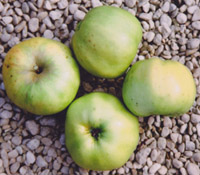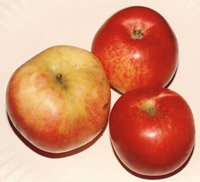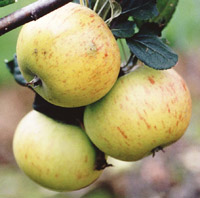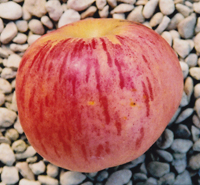
 |
|||||
|
|
|||||
|
|
|
|||||
|
|
 |
ORLEANS REINETTE A very old apple first described in 1776 by the Dutch pomologist, Knoop, and in England before 1826. It has also been known as Winter Ribston. It is most probably of French origin. It was popular in Europe for cooking as it keeps its shape very well when cooked, having a good sweet/sharp balance and a rich flavour, though it is also a very good eating apple. The fruit has a golden skin, with a red flush and some russeting. Scott describes it as ‘top quality’ and Bunyard was similarly enthusiastic; 'It is probably the sweetest dessert apple we have. An apple for the connoisseur'. Ripe in October, the storing time is quite variable, according to conditions. Sometimes the apples last into the New Year and sometimes they lose their quality in November. Attractive blossom T*. Pollination Group 5 |
||
 |
OSLIN Synonym, Arbroath Pippin. A very old Scottish apple probably introduced from France by the monks of Arbroath and thought to date back to the 17th century. The early dessert fruit is pale yellow skinned, with russet dots, and the flesh is yellowish, firm, juicy and richly aromatic. Hogg esteemed it very highly, though Bunyard was less enthusiastic. Rogers (1837) thought it among the best dessert fruits of its season, the melting flesh full of rich and pleasant juice. It is undoubtedly very good indeed. Ripe from late August, the apples will not last more than a few weeks. A good apple for cooler climates, but still good in the south. A vigorous, upright tree with good yields and dark stripy blossom. Pollination Group 2 |
|||
OTMOOR
RESERVE Just north of Oxford is the expanse of Otmoor and the
small villages that inhabit it. It is a place where hardiness is essential,
being exposed, wet and with clay that goes down a long way. Within a nature
reserve which covers part of it, is an old apple tree, popular enough
for it to be stealthily stripped of fruit, while others wait for it to
ripen. The eating apples are medium sized, very juicy, crisp and with
a complex set of flavours. It was described as “delicious”
by Peter Ross, of the Beckley Orchard Group who gave us scions from his
young tree, to graft here. It is mid to late season and will keep for
a month or two. |
||||
 |
OVER
APPLE Assumed to be from Over, west of Gloucester. A late season
dessert and culinary, medium to large apple, which has also been used
for cider. The apples are flattened round, ribbed and with green-yellow
skin. When ripe in mid October, they are very pleasant to eat raw, being
crisp, juicy and sweet, though the flesh becomes a little empty of flavour
and pulpy after chewing. Nevertheless it is a very good eating apple.
When cooked, the pale flesh softens but keeps all its shape and breaks
up tenderly in the mouth. It is very sweet and rich, with modest acid.
It would make good dried slices and be perfect for tarts or pies. Stores
to December. Pollination Group 5 |
|||
OVERLEAF
A small to medium sized apple, considered best for cider, though in some
years it can be a reasonable eating apple. In early October or before
it is useful as a cider sharp, but by mid to late October it is fairly
sweet and with a good flavour, though not crisp or juicy. It is rather
variable from year to year. The apples are not worth keeping after November.
Trees have a weeping habit. Pollination Group 5 |
||||
 |
OXFORD
BEAUTY In the 1920s and 30’s, Frederick W. Wastie, bred
many apples at his nursery at Eynsham, near Oxford. His son J. Frederick
Wastie continued to breed fruit and introduced some of his father’s
apples. The five ‘Oxford’ apples here were all bred by ‘Old
Fred’ - a small part of his output and that of his son. Oxford Beauty
was raised in 1924 from a cross between Gascoyne’s Scarlet and Scarlet
Nonpareil or Nonpareil. The skin is pale yellow, with a deep red blush
and pale dots, sometimes extending over most of the apple. The apples
are crisp, juicy and sweet, with a fair amount of acid and a strong flavour,
including a hint of strawberries. Ripe in late September or early October,
the apples will last for several weeks. Trees have a spreading habit.
Pollination Group 3 |
|||
 |
OXFORD CONQUEST A cross between Blenheim Orange and Court Pendu Plat, it was raised in 1927. The dessert apples are medium to large, with pale green/yellow skin, blushed in the sun with tawny red. Ripe quite late in the year, usually in November. The flesh is firm, sharp at first but mellowing and becoming richer and sweeter in December, when the flavour is unusual and quite powerful - sweet and with a bit of a tang. Pollination Group 3 | |||
 |
OXFORD
HOARD Raised in 1922 from Sturmer Pippin and Golden Russet, it
was first exhibited in 1942. The ribbed dessert apples are medium sized
with skin of yellow, orange in the sun. They are ripe quite late in the
year but develop a sweet aromatic flavour. Crisp, sweet and juicy in November,
they will last to the year end. Carmine pink blossom. Pollination Group
3 |
|||
 |
OXFORD
SUNRISE Probably raised in the 1920s, it was first exhibited
in 1942. A cross between Cox’s Orange Pippin and Lane’s Prince
Albert. A medium sized dessert apple with yellow/green skin streaked with
red and blushed with orange. The flesh is crisp, juicy and sweet, with
not much acid. Fruit is ripe in late October and will store into January.
Pollination Group 2 |
|||
 |
OXFORD YEOMAN Raised in 1922 from crossing Blenheim Orange with Lane’s Prince Albert. It is a large cooking apple with pale green/yellow skin, striped over most of the body with orange and scarlet. The flesh is juicy and sweet with good acid, cooking to a rich purée. Late season, keeping well into the New Year. T*. Pollination Group 3 | |||
|
||||